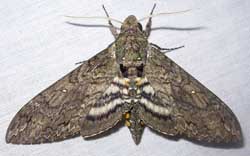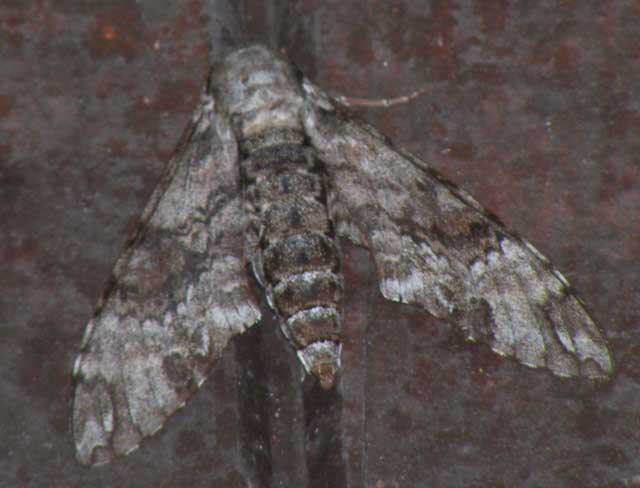Suriname: Manduca
Suriname: Manduca

Manduca florestan, Camp Caiman, near Kaw, French Guiana,
April 29, 2011, courtesy of Andres Urbas.
This checklist will become more accurate as images and information are sent to me. If you would like
to assist in the development of this worldwide Sphingidae data/image
base, please send info and images to Bill Oehlke.
I have arranged the images in accordance with my perception of wing characters: predominent markings, shape, colour,
size.
Females often have a wing shape or pattern that differs from the males. I hope some day to also have a thumbnail checklist for the females.
Manduca
Abdomen: three prominent orangey-yellow lateral marks; two rows of dorsal small white dots.
Strong presence of white scaling on forewings.

Manduca dalica dalica
110-120-135mm
Fw: dark, purplish-brown in median & subterminal areas.
Thin, black, very irregular aml inwardly traced in white, additional white along forewing base
& across thorax/abdomen juncture. Thin white line across head behind eyes.
Discal spot: large, white, connected by white triangular patch to suffusion on costal margin.
Whitish-grey apical patch, &
small, whitish mark anterior of anal angle. Space between 2nd & 3rd discal lines dark grey.

Manduca brunalba
100-104mm
Darker tegulae outlined in thin black. Two small dark triangles on thorax.
Abdomen: three prominent orangey-yellow marks on each side, dark mesial band, broken into segments.
Fw median area: blotchy dark brown in upper 3/4 with strong outward projection opposite cell. Conspicuous, continuous
white postmedian band lining outer edge.
Dark irregular aml, more visible in lower 2/3, highlighted by white scaling on both sides.
|

Manduca leucospila
100mm
Space along i.m. between aml & post-discal lines: pale, suffused with buff.
Large greyish-white patches anterior to oblique apical line, and in submarginal area.
Smaller white patch & submarginal zigzag line near anal angle. Black streak connects 3rd antemedian & 1st discal
lines between veins CuA1 and CuA2; discal lines sharply dentate, 2nd and 3rd close together, with the space between spotted with white,
the lines more evenly curved than in Manduca rustica; fringe with white spots large, extending onto the wing membrane.
|

Manduca rustica
87-150mm
Broad, dominant U-shaped whitish area from costa (just outside am line) to inner margin; along inner margin
to last pm line and inside that line to first pm line to costa. Median area bounded by this shape is grey-brown with white cell and no
white triangle joining cell to costa. Lower inside 1/4 of basal area white with white marks above. Much white in terminal area.
Note inverted white v's, like eyebrows, over dark triangles on mid thorax. Strong white presence at juncture of thorax/abdomen.

Manduca albiplaga
120-180mm
Large white apical patch in upper half of postmedian area from outside of pm line to apex; another large white patch
from costa to inner margin just outside the basal area. Two white areas not contiuous as in rustica.
|
|
Manduca
Abdomen: five-six prominent orangey-yellow lateral marks;
lacking (except for sexta paphus) two rows of dorsal small white dots.
Lacking presence of white scaling on forewings.

Manduca sexta paphus
m: 110mm; f: 117mm
Fw white, submarginal band less prominent than in sexta, but
hw bands are purer white. G.C. variable, may be as pale as sexta caestri.
Lower 3/4 of inner pml very straight.

Manduca duquefi
m: 102mm
Small grey cell mark in almost solid, very dark upper 2/3 median area.
Four angular, subparallel pm lines with much space (lighter brown) between lines
3 and 4.
No white patches or scaling on wings.
|

Manduca hannibal
m: 99-115mm; f: 106mm
G. c. different shades of brown, generous suffusions of tiny charcoal grey scales, creating somewhat grainy appearance.
Lighter colouration (creamy buff) without suffusion along i. m., anal angle, o. m.. Am and pm lines less convergent
below cell than in other species. Very weak subterminal line

Manduca diffissa tropicalis :
m: 106mm; f: 107mm
Grey brown, often darker in cell region. Terminal line tends to be more pronounced, with small rectangular like projections, than in other species in this group.
|

Manduca lucetius
m: 114mm; f: 136mm
Slaty black downy patches very pronounced,
forming, together with a patch in the discal cell, a large semicircle filled with black scaling, this contrasting strongly with the paler, russet basal and
distal areas; discal and postdiscal lines less curved than in Manduca diffissa petuniae near vein M3, but more so than in Manduca sexta; white dots of the
fringe sometimes encroaching on the wing, being slightly enlarged basad, though they may be very small or absent.
|
|
Manduca
Three to four pairs of lateral, yellow abdominal patches.
Very thin, black, apical, trapezoidal outline often broken along lower edge.
Prominent, oblique, black bar from near costa midpoint to cell.

M. prestoni
m: 112mm; f: 125mm
M. lefeburii:Very similar to Manduca lefeburii, but the forewing upperside transverse dark band that runs through the discal spot is narrower,
less diffuse, and does not reach the outer margin. It ends about 2/3 the distance to the outer margin, and is represented
by dark submarginal and marginal marks on veins M3 and CuA1. The more distal dark costal mark is more conspicuous than in Manduca lefeburii.
|
M. prestoni: bar from costa tangent to lower edge of cell,
then subparallel to inner margin.
M. lefeburii: bar from costa through cell is almost linnear, not subparallel to inner margin.
|

Manduca lefeburii
m: 89-100mm; f: 118mm
Similar to Manduca andicola. Conspicuous,
diffuse, dark band from midpoint costa to outer margin near vein CuA1, housing white discal spot.
Mostly pale grey with pale brown triangular patch from cell spot to costa.
Aml weak, outer pm line weak.
No narrow black mesial line on abdomen upperside.
|
|

Manduca huascara, Brownsberg National Park, Brokopondo District, Suriname,
July 8, 2011, courtesy of Johan van't Bosch.
Manduca
No lateral abdominal yellow patches, just whitish ones.
Thin, black outline of apical, irregular trapezoid is complete and distinct.
Two prominent, short black bars, subparallel to inner margin, below and outside cell spot.

M. huascara
m: 118-119mm; f: 127-130mm
Thorax: light grey; slightly darker grey-mixed with yellow tegulae.
Darker grey band across head and thorax juncture.
Basal & postmedian areas much lighter than median area, especially dark in upper half.
Small, almost obscure cell spot.
|

Manduca florestan
m: 100-115mm; f: 110-130mm
Fw gray to yellowish gray to brown with greenish tint in fresh specimens. Two black dashes running from below cell toward outer margin. Prominent reddish brown patch
outside cell, above dashes. Left fw pm lines: S-shaped, prominent for upper 3/4. Body side of black apical, trapezoid, oblique.
|

Manduca vestalis
m: 110mm; f: 130mm
Thorax light grey; tegulae slightly darker with
black outer edge.
One prominent, thin, distinct, S-shaped, pml on left fw. Other "pmlines" broadly diffuse.
Ground colour light grey, often with yellowish cast.
|
|
+++++++
Visit tentative Suriname Thumbnail Checklists:
You are here: Sphingini: Manduca
Sphingini: Agrius, Amphimoea, Cocytius, Amphonyx, Morcocytius, Pseudococytius
Smerinthini: Adhemarius and Protambulyx
Dilophonotini: Aleuron, Enyo, Pachygonidia and Unzela
Dilophonotini: Aellopos, Eupyrrhoglossum, Nyceryx and Perigonia
Dilophonotini: Callionima, Erinnyis, Hemeroplanes, Isognathus, Madoryx, Oryba, Pachylia, Pachylioides, Phryxus
and Pseudosphinx
Philampelini: Eumorpha
Macroglossini: Hyles and Xylophanes
Go to Main Sphingidae Index
Go to Indices of Nations
Go to South American Index
Go to Central American Index
Use your browser "Back" button to return to the previous page.
This page is brought to you by
Bill Oehlke and the
WLSS. Pages are on space rented from Bizland. If you would like
to become a "Patron of the Sphingidae Site", contact Bill.
Please send sightings/images to Bill. I will do my best to respond to
requests for identification help.








